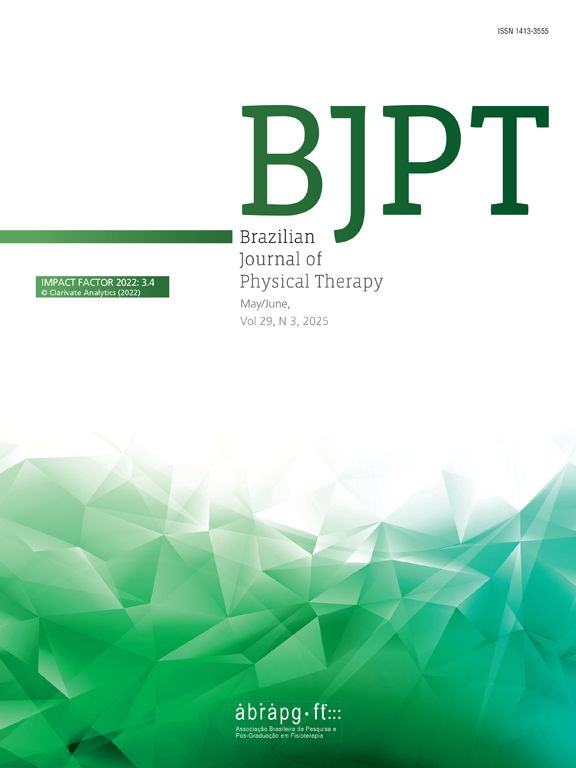7843
Pain revolution in the public health system: Active coping strategies for chronic pain unitFederico Montero-Cuadrado, Laura Barrero-Santiago, Manuel Santos-Bermejo
Braz J Phys Ther. 2025;29:101176
7843
Highlights
- •
Chronic pain care must shift to a biopsychosocial model focused on functionality.
- •
Interdisciplinary work is essential in the management of chronic pain.
- •
Exercise in active coping strategy should consider psychosocial, emotional, and contextual factors.
4147
Physical therapy assistance in labor: A systematic review and meta-analysisAlexandre Delgado, Andrea Lemos, Geyson Marinho, Renato S. Melo, Filipe Pinheiro, Melania Amorim
Braz J Phys Ther. 2025;29:101169
4147
Highlights
- •
Physical therapy assistance during labor increases the chances of vaginal delivery.
- •
Physical therapy assistance during labor reduces the risk of a cesarean delivery.
- •
Physical therapy assistance during labor reduces the intensity of pain and maternal anxiety.
- •
Physical therapy assistance during labor reduces the risk of perineal laceration, and reduces the need for pharmacological analgesia.
3444
The most effective therapeutic exercises for pain intensity in women with fibromyalgia: A systematic review and network meta-analysisÁlvaro-José Rodríguez-Domínguez, Manuel Rebollo-Salas, Raquel Chillón-Martínez, Abel Rosales-Tristancho, Inmaculada Villa-del-Pino, José-Jesús Jiménez-Rejano
Braz J Phys Ther. 2025;29:101226
3444
Highlights
- •
Resistance training was the only therapeutic exercise (TE) approach that showed clinical relevance, in the short and long term, to reduce pain intensity in women with fibromyalgia, showing a moderately important improvement (>30 %).
- •
In the short term, aquatic exercise was the most effective approach to reduce pain intensity, so it could be an appropriate option to start a TE program in women with fibromyalgia.
- •
These findings could contribute to a change in the current paradigm on TE prescription in fibromyalgia, because the “gold standard” recommendation of aerobic exercise should be replaced by other more effective approaches.
- •
The results provide a valuable tool for decision making when choosing the most appropriate TE approach according to the patient's characteristics and preferences, because it is a key factor in improving adherence to treatment.
3252
ASSOBRAFIR clinical practice guidelines in cardiovascular physical therapy: Exercise-based interventions in outpatient rehabilitation programs for heart failureMarlus Karsten, Giulliano Gardenghi, Alessandra Choqueta Toledo Arruda, Aparecida Maria Catai, Ariany Marques Vieira, Cinara Stein, Cintia Laura Pereira de Araujo, Danielle Aparecida Gomes Pereira, ... Gerson Cipriano
3252
Highlights
- •
Supervised high-intensity interval training (HIIT) and moderate-intensity continuous training (MICT) are options for heart failure treatment in cardiovascular rehabilitation programs (CoR, low CoE).
- •
Supervised moderate-intensity resistance training (MIRT) may be more effective than low-intensity resistance training (LIRT) for heart failure with preserved ejection fraction (HFpEF) patients (CoR, very low CoE).
- •
High-intensity inspiratory muscle training (HI-IMT) improves inspiratory muscle strength/endurance in heart failure patients (CoR, very low CoE).
- •
Aerobic training (AT) plus neuromuscular electrical stimulation (NMES) offers no extra benefit over AT alone for heart failure patients (CoR, low CoE).
- •
NMES is more effective than NMES placebo or usual activities for heart failure patients (CoR, low CoE).
3031
Rehabilitation management of the chronic pain-hypertension synergy: Proposal of an evidence-informed frameworkRenzo Mendoza, Craig Hensley, Jennifer Ryan, Todd Davenport
Braz J Phys Ther. 2025;29:101229
3031
Highlights
- •
Chronic pain and hypertension (HTN) are intertwined global health challenges, with substantial societal and economic burdens.
- •
Evidence suggests a bidirectional relationship between chronic pain and HTN, influenced by shared risk factors such as metabolic syndrome, obesity, poor sleep quality, and mental health conditions.
- •
Physical therapists (PTs) can play a pivotal role in managing patients with chronic pain and HTN through evidence-informed screening, assessment, and interventions.
- •
The proposed framework integrates biopsychosocial models for personalized pain management and emphasizes blood pressure monitoring for safe, effective interventions.
2605
Acute effect of aerobic and resistance exercise on glycemia in individuals with type 2 diabetes: Systematic review and meta-analysisJosiane Aparecida de Almeida, Ana Paula Delgado Bomtempo Batalha, Carolina Vargas de Oliveira Santos, Tamiris Schaeffer Fontoura, Mateus Camaroti Laterza, Lilian Pinto da Silva
Braz J Phys Ther. 2025;29:101146
2605
Highlights
- •
Exercise is a fundamental component in treating type 2 diabetes.
- •
The glycemic response to a single exercise session differs based on exercise type.
- •
Continuous aerobic exercise reduces glycemia up to 10 min after its completion.
- •
Interval aerobic exercise reduces glycemia up to 30 min after its completion.
- •
Resistance exercise reduces glycemia up to 1 min after its completion.
2333
A Brazilian Association of Women´s Health Physical Therapy (ABRAFISM) guideline on the terminology of pelvic floor muscle function and assessmentPatricia Driusso, Cristine Homsi Jorge, Ana Jéssica dos Santos Sousa, Daniela Fantin Carro, Leticia Maciel de Freitas, Simone Botelho, Luiz Gustavo Oliveira Brito, Maria Augusta Tezelli Bortolini, ... Elizabeth Alves Ferreira
Braz J Phys Ther. 2025;29:101173
2333
Highlights
- •
The guideline establishes a consensus on anatomical terminology, signs/symptoms, and assessment of pelvic floor (PF) muscles in women, based on a systematic literature review, involving 21 Women's Health/Pelvic Floor experts.
- •
Clearly defined PF terminology in Brazilian Portuguese enhances clinical and scientific discussions by eliminating ambiguity.
- •
The guideline is expected to be widely used from undergraduate education to the evaluation and treatment of PF dysfunctions in research and clinical practice.
2308
Association between pitching velocity and elbow varus torqueScott Peters, Garrett S. Bullock, Kristen F. Nicholson
Braz J Phys Ther. 2025;29:101222
2308
Highlights
- •
Small associations were seen with pitching mechanics and elbow torque when controlling for pitch velocity. This suggests that varus torques can potentially be reduced while maintaining pitch velocity.
- •
Optimizing pitching efficiency by improving small aspects throughout the delivery will likely lead to increased coaching effectiveness vs attempting to find one variable.
- •
Differences in association were seen in pelvic rotational velocity and thoracic rotational velocity, suggesting potential ramifications for the oblique musculature in force generation. This is an area for further research and focus.
2301
Reliability of the McKenzie Method of Mechanical Diagnosis and Therapy in the examination of spinal pain, including the OTHER classificationsHans van Helvoirt, Henk Tempelman, Puck van der Vet, Frank van der Vet, Job van Helvoirt, Richard Rosedale, Adri Apeldoorn
Braz J Phys Ther. 2025;29:101154
2301
Highlights
- •
The Mckenzie Method of Mechanical Diagnosis and Therapy (MDT) spinal classification system consists of three main MDT syndromes and the classification OTHER.
- •
In reliability studies, the 10 different classifications under OTHER (e.g. spinal stenosis, chronic pain syndrome) has always been grouped together as one classification.
- •
In a Dutch medical centre (Rugpoli) that provides secondary and tertiary level care, the prevalence of patients classified as OTHER is 63%.
- •
The results showed that the reliability between experienced, highly trained MDT clinicians of Rugpoli was almost perfect.
2226
Shoulder pain phenotyping: A guide for clinicians to determine predominant nociceptive, neuropathic, or nociplastic shoulder painLiesbet De Baets, Kevin Kuppens, Céline Labie, Melina Nevoeiro Haik, Eleni Kapreli, Paraskevi Bilika, Filip Struyf, Dorien Borms, ... Jo Nijs
2226
Highlights
- •
Pain phenotypes responsible for persistent shoulder pain can be complex and dynamic.
- •
Presentation of shoulder pain phenotype assessment and clinical reasoning.
- •
Knowledge gaps on characteristics of patients per specific shoulder pain phenotype.
2170
Association between contextual factors and vulvovaginal symptoms in Brazilian women: A cross-sectional studyClara Maria de Araujo Silva, Tatiana de Oliveira Sato, Vanessa Patrícia Soares de Sousa, Natália Duarte Pereira, Daiana Priscila Rodrigues-de-Souza, Ana Carolina Sartorato Beleza
Braz J Phys Ther. 2025;29:101184
2170
Highlights
- •
Educational level and number of pregnancies were associated with vulvovaginal symptoms.
- •
Vaginal discharge and itching were the most prevalent vulvovaginal symptoms.
- •
Vulvovaginal symptoms had a low impact on quality of life.





